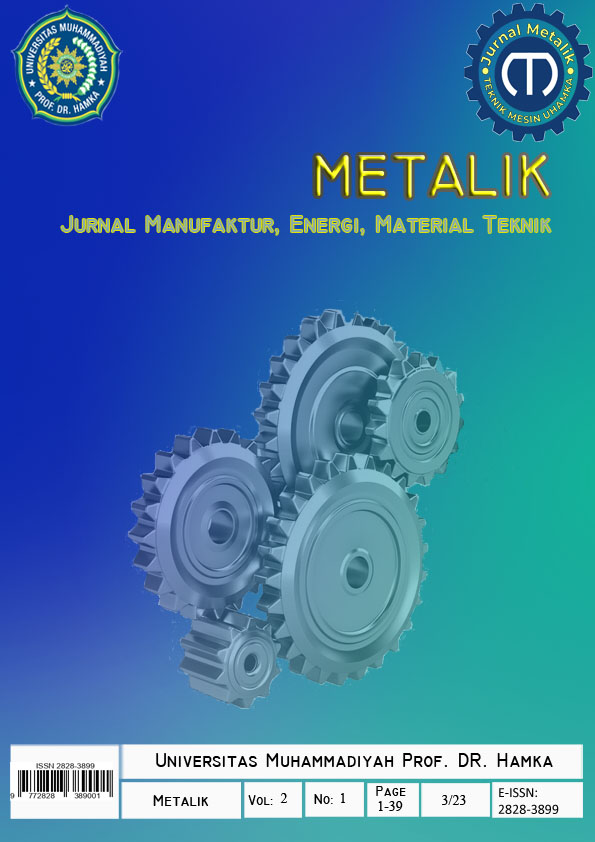Pengaruh Tegangan Listrik dan Arus Listrik terhadap Kinerja Termoelektrik Sebagai Pendingin Termoelektrik
DOI:
https://doi.org/10.22236/metalik.v2i1.12426Keywords:
thermoelectric, temperature, performance, thermoelectric coolerAbstract
Thermoelectric material is a material that has thermal and electrical properties. The thermoelectric module can function as an electric generator, heat pump and cooler. The thermoelectric modules used in this study are the TEC 1-12706 type and the TEG SP 1848 type. This study uses both of these modules with each module using four thermoelectrics to be used as a cooling system. The purpose of the research is to obtain the lowest temperature on the cold side and the highest CoP thermoelectric performance coefficient on the two different modules with variations in the size of the electric voltage and electric current that have been determined, then to get a thermoelectric module that has a higher performance coefficient of the two types of thermoelectric modules used. used. The research method used is experimental. The two modules are separately supplied with DC electrical energy so that heat is absorbed on the cold side and heat is released on the hot side so that a temperature difference occurs, and an aluminum heatsink is attached to the cold side and the hot side. The data obtained from the input data are ambient temperature, electric voltage, and electric current. Then what is obtained from the output data is the temperature of the hot side, the temperature of the cold side, and the temperature of the cold room. The results of the study on the TEC 1-12706 module with variations in electric voltage produce a minimum cold side temperature of 5.9°C with the highest CoP value of the cooling system of 0.1821, while variations in electric current produce a minimum cold side temperature of 8.0°C with the highest CoP value of the cooling system of 0.3247. For the TEG SP 1848 module, variations in electric voltage produce a minimum cold side temperature of 8.3°C with the highest CoP value of the cooling system of 0.2371, while variations in electric current produce a minimum cold side temperature of 11.1°C with a CoP value the highest cooling system is 0.2158. Thus this study achieved the result that the use of the TEC 1-12706 module with variations in electric voltage produced the lowest temperature of 5.9 oC. While the use of TEC 1-12706 with variations in electric current produces the highest CoP value of 0.3247. There for the TEC 1-12706 module has a higher performance than the TEG SP 1848 module in terms of the lowest temperature achievement and the highest CoP value.
Downloads
References
H. Ima Maysha, Bambang Trisno, “Pemanfaatan Tenaga Surya Menggunakan Rancangan Panel Surya Berbasis Transistor 2N3055 dan Thermoelectric Cooler,” Electrans, vol. 12, no. 2, pp. 89–96, 2013.
J. S. Sumbodo, M. R. Kirom, and P. Pangaribuan, “Efektifitas Pendingin Menggunakan Termoelektrik Pada Panel Surya,” e-Proceeding Eng., vol. 5, no. 3, pp. 3895–3902, 2018.
L. Nulhakim, “Uji Unjuk Kerja Pendingin Ruangan Berbasis Thermoelectric Cooling,” Simetris J. Tek. Mesin, Elektro dan Ilmu Komput., vol. 8, no. 1, pp. 85–90, 2017, doi: 10.24176/simet.v8i1.829.
S. S. Wisnu Indrawan, “Sistem Pendingin Menggunakan Thermo-Electric Cooler dengan Kontroler Proportional-Integralderivative,” Berk. Fis., vol. 22, no. 2, pp. 68–76, 2019.
N. Putra, R. A. Koestoer, M. Adhitya, A. Roekettino, and B. Trianto, “Potensi Pembangkit Daya Termoelekrik untuk Kendaraan Hibrid,” Makara Teknol., vol. 13, no. 2, pp. 53–58, 2009.
A. Rifky, Fikri and M. Mujirudin, “Atap dan Dinding Bangunan sebagai Media Konverter Energi Termal Matahari menjadi Energi Listrik,” vol. 1, no. 1, pp. 1–6, 2021.
L. K. Kin, A. T. Baheta, and K. Habib, “Analytical Investigation of Thermoelectric Performance for Cooling Application,” J. Adv. Res. Fluid Mech. Therm. Sci., vol. 46, no. 1, pp. 32–40, 2018.
H. Haryanto, M. R. Makhsum, and I. Saraswati, “Perancangan Modul Termoelektrik Generator Menggunakan Peltier,” Tek. J. Sains dan Teknol., vol. 11, no. 1, p. 26, 2015, doi: 10.36055/tjst.v11i1.6970.
R. Rifky and Y. Sirodz, “Pengembangan Model Pendingin Kabin City Car Bertenaga Surya Menggunakan Photovoltaics (PV) dan Thermoelectric (TEC),” Teknobiz J. Ilm. Progr. Stud. Magister …, vol. 10, no. 1, pp. 34–40, 2020.
Ginanjar, A. Hiendro, and D. Suryadi, “Perancangan dan Pengujian Sistem Pembangkit Listrik Berbasis Termoelektrik dengan Menggunakan Kompor Surya sebagai Media Pemusat Panas,” J. Tek. Elektro Univ. Tanjungpura, vol. 2, no. 1, 2019.
Y. Wiradika, “Analisa Variasi Luasan Heatsink terhadap Unjuk Kerja Modul Generator Termoelektrik (TEG) Memanfaatkan Panas Buangan Kondensor Kulkas,” Universitas Jember, 2019.
H. Lee, Thermal Design. 2010.
A. W. Jatmiko, “Kotak Pendingin Berbasis Thermoelectric,” Universitas Sanata Dharma, 2014.
H. Prasetyo, “Analisis Pengaruh Luasan Heatsink terhadap Unjuk Kerja Portable Mini Refrigerator,” Universitas Jember, 2015.
N. Sulistiyanto, “Pemodelan Sistem Pendingin Termoelektrik pada Modul Superluminance LED,” J. EECCIS, vol. 8, no. 1, pp. 67–72, 2014.
Amrullah, Z. Djafar, and W. H. Piarah, “Penerapan Termoelektrik Ganda pada Mesin Pendingin Air Minum sebagai Solusi Penghematan Energi,” J. Teknol. Terap., vol. 1, no. 1, pp. 42–48, 2015.
L. Shen, X. Pu, Y. Sun, and J. Chen, “A study on Thermoelectric Technology Application In Net Zero Energy Buildings,” Energy, vol. 113, pp. 9–24, 2016, doi: 10.1016/j.energy.2016.07.038.
F. Fimansyah, “Pengembangan Cool Box Ramah Lingkungan untuk Kendaraan Roda Dua Berbasis Termoelektrik,” Universitas Indonesia, 2009.
A. Suryadi and A. Firmansyah, “Rancang Bangun Kulkas Mini Portable Menggunakan Peltier,” Simetris J. Tek. Mesin, Elektro dan Ilmu Komput., vol. 11, no. 1, pp. 11–22, 2020, doi: 10.24176/simet.v11i1.3361.
Hendri, “Pengujian dan Perhitungan Beban Panas pada Kotak Pendingin yang Menggunakan Termoelektrik dengan Sumber Energi Surya,” Universitas Sumatera Utara, 2015.
Amrullah, “Uji Eksperimental Kinerja Termoelektrik pada Pendingin Dispenser Air Minum,” Universitas Hasanuddin, 2013.
R. F. Kusuma, M. J. Afroni, and O. Melfazen, “Perhitungan Efisiensi Peltier TEG(Thermoelectric Generator) SP-1848 Menggunakan Perbandingan Suhu Panas dan Dingin sebagai Energi Alternatif,” Sci. Electro, vol. 13, no. 1, 2021.
F. S. Gianita, “Kaji Eksperimental Portable Cool Box Menggunakan TEC1-12705 Cascade,” Tugas Akhir, pp. 1–65, 2017.
Kennedy, K. Anwar, and M. B. Anggara, “Pengaruh Laju Aliran Fluida Liquid-Cooled Heat Sink Terhadap Unjuk Kerja Sistim Pendingin Termoelektrik,” pp. 1–8, 2016.
Nandy Putra & Axel Hidayat, “Pengembangan Alat Uji Kualitas dan Karakteristik Elemen Peltier,” Semin. Nas. Tah. Tek. Mesin V , no. November, pp. 21–23, 2006.
N. Putra and F. N. I, “M5-018 Pengujian Kemampuan Pendinginan Prototipe Kotak Sampel Darah Berbasis Thermoelektrik dan Heat Pipe,” Semin. Nas. Tah. Tek. Mesin VIII, no. X, pp. 552–560, 2009.
Downloads
Published
How to Cite
Issue
Section
License
Copyright (c) 2023 METALIK : Jurnal Manufaktur, Energi, Material Teknik

This work is licensed under a Creative Commons Attribution-NonCommercial 4.0 International License.
















